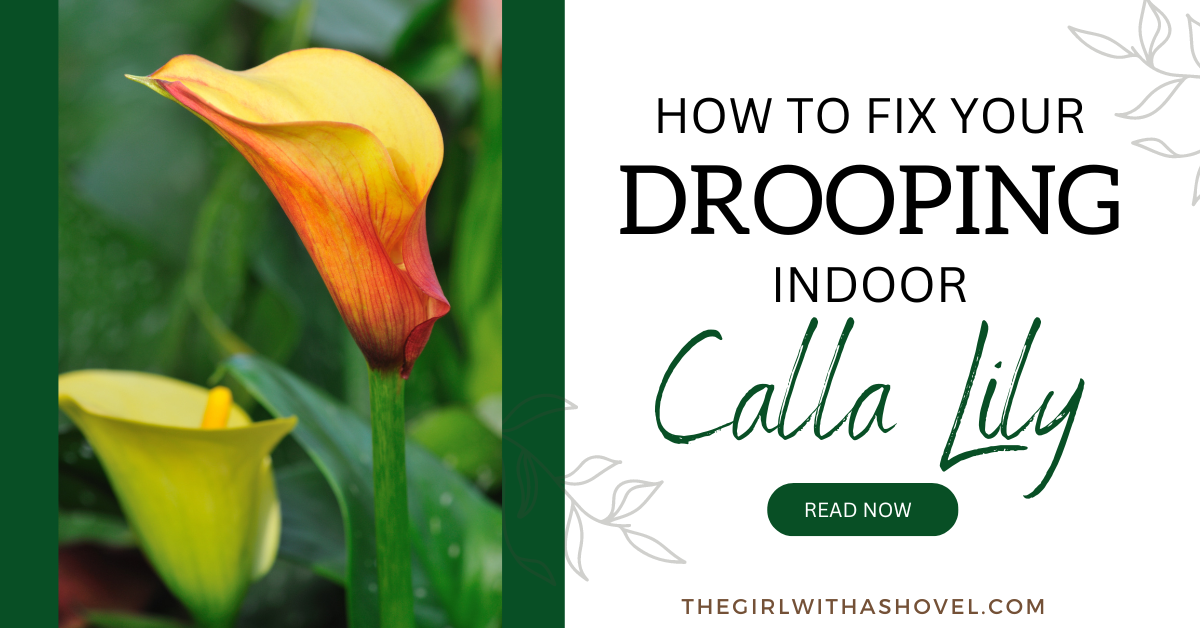Hey there, plant pals! Have you ever noticed your beautiful indoor calla lily drooping like a sad puppy? It’s happened to me more times than I’d like to admit, and let me tell you, it’s a real bummer. But fret not, because I’ve been there, done that, and learned a thing or two about why our precious lilies might be feeling a little down in the dumps. So, if you’re wondering why your calla lily is drooping, stick around because I’m about to tell you exactly what might be causing those droopy leaves. Let’s troubleshoot together, shall we?
Here’s what we’re covering today…
- Understanding Why Calla Lilies Droop Indoors
- Identifying and Fixing the Problems
- Proper Care for Calla Lilies Indoors
- Pros and Cons of Keeping Calla Lilies Indoors
- Conclusion
- Indoor Calla Lily Care FAQs
Read on to figure out why your calla lily is drooping and how to keep your plant looking beautiful and happy indoors!
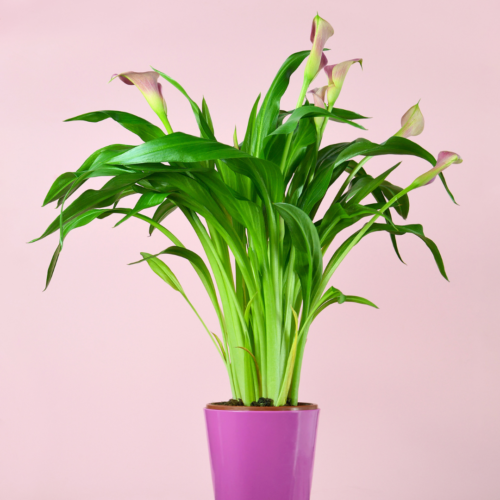
Understanding Why Calla Lilies Droop Indoors
So let’s figure out exactly why your calla lily is drooping. First, let’s keep in mind that calla lilies, or zantedeschia aethiopica, are mostly perennials that originate from areas with a temperate climate, mainly the lush areas of South Africa. This is why they do best with warm temperatures, adequate humidity, and lots of bright, indirect light – a condition that can sometimes be hard to replicate indoors. When these conditions are not met, you may notice your calla lilies starting to droop.
Common reasons behind their drooping indoors include:
- overwatering
- underwatering
- inadequate light
- sudden temperature changes
- stress from transplanting
- inadequate nutrients
Any one of these many different reasons can cause your calla lily to droop. So how in the world are your supposed to know which of these things is causing your exact droopiness? In the next sections I’m going to address the additional signs you can look for to determine the true culprit of your sad-looking calla lily…

Identifying and Fixing the Problems
Identifying Signs of Distress
Aside from the obvious drooping, there are several signs your calla lily might show if it’s distressed. Yellow leaves, slow growth, brown leaf tips, and a lack of new flowers are all clear indications something might be off with your calla lily. Each one of these signs can help you determine which is the cause of your drooping.
Overwatering & Underwatering
Watering is the most common problem when it comes to drooping calla lilies. These plants prefer a moist, but not soggy environment. If the leaves are yellow and drooping, the plant may be overwatered. If the leaves are brown and wrinkly and the soil is dry, the plant is likely underwatered. So the easiest way to check this is to feel your soil. If the soil is wet and your plant is drooping, then this is most likely caused from overwatering. But if your soil is dry, then your drooping is most likely caused by underwatering.
To correct these issues, adjust your watering routine. Allow the top inch or so of the soil to dry out before watering again. If your soil is too moist, then you should consider repotting it or taking it out of the pot to try to dry out the soil more quickly. Then stop adding so much water to your plant at each watering, or add more perlite or sand to your plant’s soil to increase drainage.
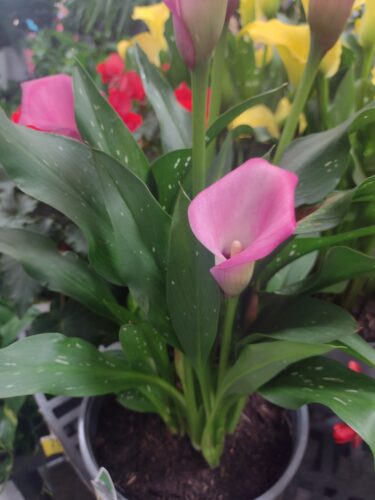
Insufficient Light
Calla lilies love bright, indirect light. If your plant is not getting enough light it may start to droop. One of the signs that you can see from insufficient light is if your plant’s leaves are still green but are drooping, and any new growth is looking thin. If this is your plant, then you know that your plant is not receiving enough light. Consider moving it closer to a bright window, but keep it out of direct sunlight as this can scorch the leaves. You can also consider moving it outdoors in partial shade if the temperature is above 60 degrees F.
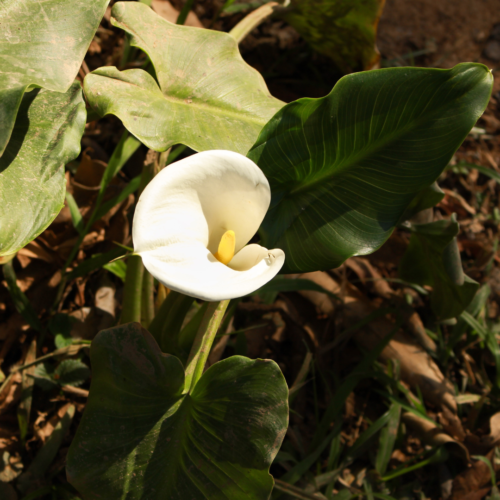
Temperature Stress
Calla lilies prefer room temperatures between 65 and 75 degrees Fahrenheit. If your home is too hot or too cold, this can cause the lily to droop and show other signs of distress, such as slower growth.
Look for any black sections on your plant, which is a sign of cold stress. Also check to see if your plant is near any exterior doors or heating or cooling vents. These can all cause hot or cold drafts and can cause your plant’s leaves to start drooping.
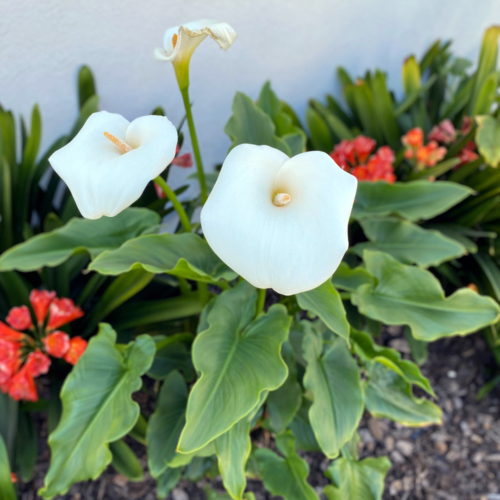
Stress from Transplanting
If your calla lily is drooping, but you’ve recently transplanted it, then this is about the best situation you could be in! That’s because this drooping is just due to transplant shock. This usually happens when the plant’s roots have been cut or damaged during the transplanting process and so the leaves are drooping because your plant isn’t able to get enough water throughout the damaged roots, so it can’t maintain the same level of water turgidity in the cells that is required to keep your plant upright. Make sense? (Sorry, that’s me nerding out for a second!)
What to look for here is first, if you’ve recently transplanted your plant. Second, the leaves should still be green, no yellowing.
If it’s yellowing, then you’ve given it too much water. Especially if you’ve cut a few roots, then these roots are open to bacterial and fungal diseases. I would suggest you let your soil dry out a bit before your next watering. This can help those cuts in the roots seal.
But if it’s still green, just drooping, then simply keep an eye on it. Be careful to not overwater during this time, and look for it to recover in about a week. If it doesn’t recover, then check out one of the other causes to see if there are multiple things going on with your lily…
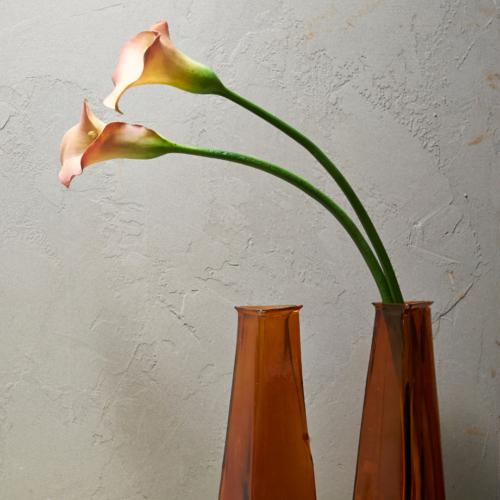
Inadequate Nutrients
The final reason of why your calla lily indoors could be drooping is because of a lack of nutrients. I will say that this is not super common though. It is mostly seen when the plant has been in the same pot for a long time and it has been flowering a lot while in this same pot. The calla lily flowers take a large amount of nutrients to grow.
To fix this, simply wait for the plant’s growing season (from spring through fall), and give your plant some indoor plant fertilizer. Follow the instructions on the back of the container for proper dosage. Also, make sure that you use a flowering houseplant fertilizer. This usually has a lower concentration of nitrogen. This is because too much nitrogen can cause plenty of leaf growth, but little to no flowering! (And I’m sure you keep this plant becuase of it’s beautiful flower!)
I did want to note, though, if your lily continues to droop after making these adjustments, you may want to look into possible diseases, such as powdery mildew, or pest issues, such as spider mites. But, these causes of plant drooping are much more rare for indoor calla lilies and each have unique signs and symptoms (such as little webbing on your plant, or white mold growing on your plant).
To wrap up this section, in most cases, your calla lily plants are drooping because of one of the above reasons. But by simply adjusting the plant’s environment and care routine, you can usually fix these problems. In the next section I’ll be explaining a bit about what calla lilies love indoors, as well as some pros and cons to enjoying these plants in your indoor garden.
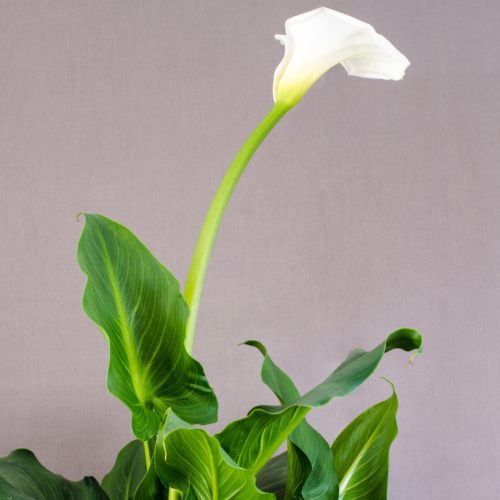
Proper Care for Calla Lilies Indoors
Proper care of calla lilies indoors is essential for ensuring their health and preventing drooping. This beautiful houseplant requires certain conditions to thrive indoors, and this includes appropriate watering, adequate lighting, fertilizer, and optimal temperature conditions.
Watering
Balance is key when it comes to watering your calla lilies. They like their soil to be consistently moist, but not waterlogged. Overwatering can lead to root rot (bacterial soft rot), which is a common cause of drooping. On the flip side, a lack of water can cause the plant to dehydrate and wilt.
As a general guide, water your calla lilies when the top inch of soil feels dry to the touch. If it comes to watering day and you still have moist soil, then don’t water your plant! Instead, wait longer until your plant’s soil has begun to dry out. But if it’s been over a week and your plant’s soil still has excess moisture, then this is a sign that either your soil or your pot has poor drainage. Consider repotting it into a pot with drainage holes and with fresh, well-draining potting mix.
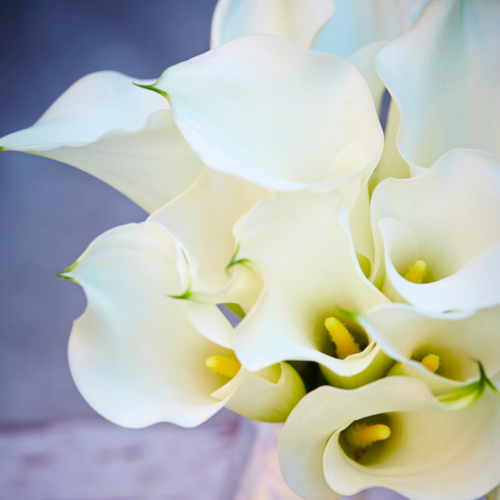
Lighting
Calla lilies prefer bright, indirect light. Being understory plants, they are accustomed to strong sunlight filtered through higher vegetation. Too much sunlight can scorch their leaves, while too little light can lead to leggy growth and reduced flowering. A north or east-facing window is typically a suitable location for an indoor calla lily. Full sun can be tolerated in the mornings, but then your plant should be sheltered from hot afternoon and evening sunlight.
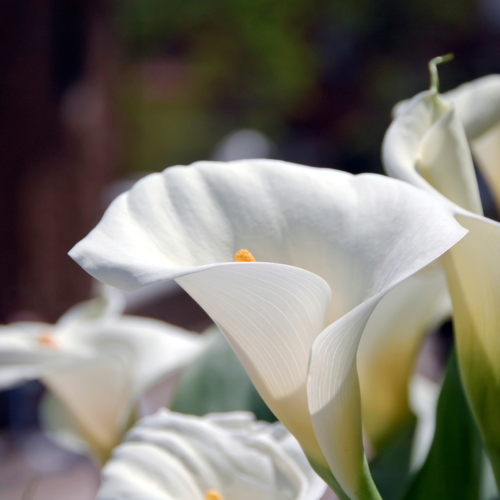
Temperature and Humidity
Calla lilies are a tropical plant. Because of this, they are used to warm, humid environments. Indoors, they do best in temperatures between 65-75ºF. They can tolerate lower temperatures, but anything below 55ºF could harm them and cause drooping. As for humidity, moderate levels (aka, higher than the typical indoor humidity levels) are ideal. However, they can adapt to average indoor humidity. Use a tray of water or a humidifier to increase humidity levels if needed.
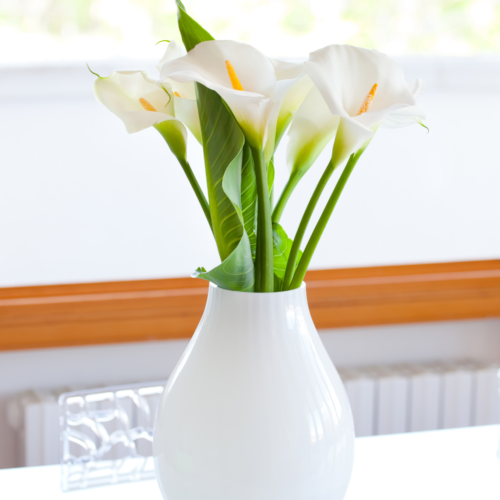
Fertilizer
Calla lily plants use a lot of energy and nutrients to produce their beautiful flowers. This is why fertilizing these plants to replenish these nutrients is essential. Use an indoor plant fertilizer that is specific for flowering houseplants. This will give them the right ratio of nitrogen to potassium that is needed to produce more flowers (not just leaves). Make sure that you only fertilize your plant in the spring through the late summer/early fall. Do not fertilize your plant in the winter months. This can cause there to be too much fertilizer in your soil, which can cause a chemical burn on your plant.
In summary, to keep your calla lilies from drooping indoors, you need to provide them with the right amount of water, proper lighting, fertilizer, and a suitable temperature. These important care steps will ensure that your indoor calla lilies are healthy, vibrant, and thriving.
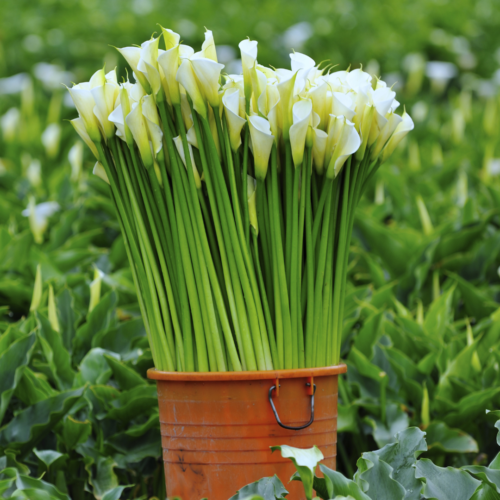
Pros and Cons of Keeping Calla Lilies Indoors
Like any indoor plant, keeping calla lilies indoors has its pros and cons. Understanding these can help you decide whether this plant is the right fit for your home and lifestyle.
Pros
- Beautifies your space: With their large, heart-shaped leaves and trumpet-shaped flowers, calla lilies can add a touch of elegance to any room.
- Purifies the air: Like many indoor plants, calla lilies help cleanse the air, contributing to a healthier living environment. Here’s my list of additional plants that clean the air.
- Relatively easy to care for: Despite their exotic appearance, calla lilies are fairly easy to maintain once their basic care needs are met. For more easy-to-care-for plants, check out my list of beginner houseplants.
Cons
- Sensitive to poor care: Calla lilies can wilt or droop if not watered properly or exposed to unsuitable light and temperature conditions.
- Potentially toxic: Keep in mind that all parts of the calla lily plant are toxic if ingested. So, they should be kept out of reach of children and pets. If you need plants that are safe for your pets, check out my list of non-toxic houseplants!
- Requires maintenance: To keep them healthy and blooming, calla lilies need to be maintained through fertilizing and annual repotting. This can be a chore for people used to buying cut flowers and simply discarding them when they are spent.
In the end, the decision to grow calla lilies indoors will depend on weighing these pros and cons. Most people find that the beauty and air-purification benefits of indoor calla lilies are worth the extra care they require. (I personally love the look that the leaves add to the space… they look just like a peace lily when potted!)
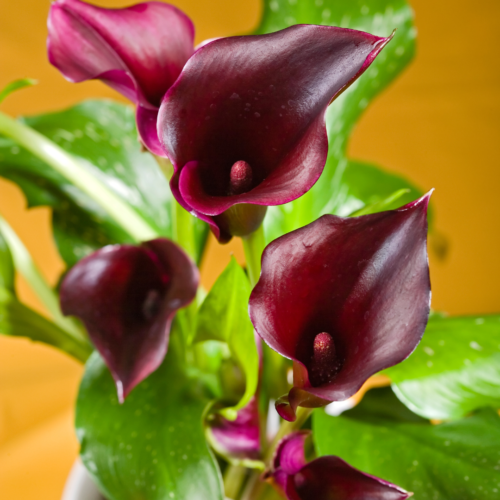
Conclusion
To wrap things up, we’ve talked a bit about why your calla lily might be drooping indoors, how you can identify and fix the root cause of your drooping, and what is the best way to properly care for your calla lily indoors. We’ve also talked about the pros and cons of keeping your plant indoors. Overall, if you live in one of the warm environments that can support calla lilies outdoors, I’d say why not just simplify your life and grow it outdoors? Then you can bring the cut flowers indoors when they are blooming! And you could get an easier houseplant (the peace lily) to achieve a similar look. But that’s just me. I do love houseplants, but there comes a time when some plants just grow better outdoors.
Unless you live in the cold north. Then definitely keep it inside!
And now that you’ve read this article, you’re fully equipped to keep your indoor calla lily alive and thriving! So good luck getting your plant back up to optimal health and enjoy the beautiful elegance this plant can bring to your indoor space.
Happy Digging!
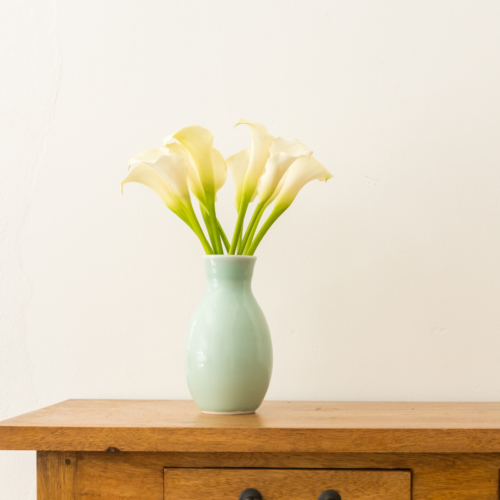
Indoor Calla Lily Care FAQs
Why are my indoor calla lilies drooping?
Drooping in indoor calla lilies may be due to a few causes. The most common are overwatering, insufficient light, or temperature extremes. Check out my article to help see the additional cues to determine which of these reasons are causing your calla lily to droop.
How can I fix drooping in my calla lilies?
You can fix drooping in calla lilies by identifying the source of stress. Check your watering routine, the lighting conditions, and the temperature of the room. Typically, by adjusting these factors, it will help your plant revive and will prevent further drooping.
What is the basic care for indoor calla lilies?
Basic care for indoor calla lilies involves proper watering, which usually means keeping the soil consistently damp but never soggy, providing bright, indirect light, and maintaining a room temperature above 55°F. Regular feeding during the blooming season and adequate humidity will also add to their healthy growth.
What are the challenges of keeping calla lilies indoors?
The main challenges of growing calla lilies indoors include managing their lighting needs, providing the right amount of water, and maintaining the correct temperature. Calla lilies need plenty of light, regular watering without being waterlogged, and a room temperature above 55°F.

